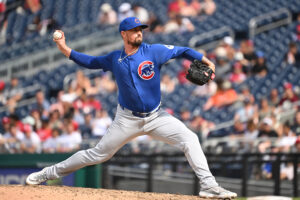Enshrinement in the MLB Hall of Fame is an honor designated for the top 1% of players to ever play the game. If that is the case, then surely accomplishing a feat that, at the time, had only been done by 13 other pitchers, warrants induction. Throw in the longevity of a 20-year-career and multiple signature postseason moments and it is clear that Curt Schilling is a man who belongs in Cooperstown.
Even so, Schilling is entering his eighth season on the ballot, having not received the necessary 75% of the vote for enshrinement. This has to do with a mixture of his public perception as well as certain aspects of his overall resume.
Favorable Factors
Strikeouts
Schilling is a member of the previously-referenced 3,000 strikeout club. Membership in the club speaks for itself. As of 2020, there are 18 members in that club with CC Sabathia and Justin Verlander joining in 2019.
The significance of this accomplishment may be undermined given the recent influx of pitchers reaching the threshold. Of the 18 pitchers to strikeout 3,000 batters, eight of them have been since 2000, Schilling included. That being said, there have been 9,844 pitchers to face at least one batter in MLB history. Only 18 of those 9,844, or about 0.2% have done it (Schilling was number 14).
If the Hall of Fame is truly meant for the top 1% of players ever, than surely 3,000 strikeouts puts one in that category. 18/9,844 would put Schilling far into the top 1%.
Playoff Success and Signature Moments
The postseason was a time where Curt Schilling thrived. In 133.1 innings pitched, he has an 11-2 record, 2.23 ERA, and 0.968 WHIP.
The criteria that qualifies a player for the Hall of Fame is listed as such:
“Voting shall be based upon the player’s record, playing ability, integrity, sportsmanship, character, and contributions to the team(s) on which the player played.”
While playoff success is not a specific criteria for induction, surely the argument can be made that having a strong impact in the postseason falls under the umbrella of a player’s contribution to his team(s).
Signature Moments
Not only has Curt Schilling had a significant impact in the postseason for one team, but multiple teams. In 1993, he was the NLCS MVP with a 1.69 ERA in two starts, helping the Philadelphia Phillies knock off the 104-win Atlanta Braves in six games. Two blown saves prevented Schilling from factoring into any decision, but he pitched eight innings in both games, allowing three total earned runs. In the World Series, he kept the Phillies alive with a five-hit shutout in Game 5, throwing 147 pitches against the Toronto Blue Jays.
In 2001, Schilling was named CO-MVP of the World Series with Randy Johnson, helping the Arizona Diamondbacks win their only World Series championship. Although Schilling left Game 7 of that series trailing, he dominated the entire series.
He pitched on short rest twice to start Game 1, Game 4, and Game 7. He only allowed 16 base runners in 21.1 innings pitched in the series with a 1.69 ERA and a 13.0 K/BB ratio against the three-time-defending World Series champion New York Yankees.
His final signature moment came in 2004. His infamous ‘Bloody Sock’ game was an integral part in the Boston Red Sox completing their comeback from down 3-0 against the Yankees in the ALCS.
An impromptu operation would repair Schilling’s injured ankle tendon, allowing him to pitch in the game. As he stood tall on the mound, blood staining his sock as a byproduct of the stitches, he managed to shut down the Yankees in Yankee Stadium and force Game 7. He pitched seven innings and allowed four hits and one run.
If contributions to a player’s team is criteria for induction, it is clear that Schilling has had a significant impact on the history of three different franchises.
Longevity
Having pitched for 20 seasons, Schilling accomplished a lot throughout his career. He was a six-time All Star. In the Cy Young award vote he has four, top-five finishes, three of which were as the runner-up.
He led the league in wins and WHIP twice. His durability was demonstrated throughout his career as seen by his four times leading the league in complete games. Additionally, his two instances of leading in innings pitched, with nine seasons of 200+ innings further emphasize that point.
Schilling also demonstrated pinpoint control. He has three, 300-strikeout seasons, and he is one of four men to accomplish the feat that many times. Additionally, he led the league in K/BB ratio five times, finishing with a 4.38 mark for his career.
Unfavorable Factors
Earned Run Average
Curt Schilling has a career ERA is 3.46, which is 399th all time. According to Baseball-Reference.com, the average Hall of Fame pitcher’s ERA is 3.00, which includes relief pitchers. If Schilling were to be inducted, he would be the 70th ranked pitcher in terms of ERA.
Although his ERA ranks in a lower tier than his strikeouts, Schilling does compare favorably to other recent inductees. Since 2014, four starting pitchers have been inducted who also fall in that tier for ERA.
Roy Halladay‘s 3.38 ERA is currently 68th among the 81 Hall of Fame pitchers. Additionally, Tom Glavine‘s 3.54 is 73rd, Mike Mussina‘s 3.68 is 78th, and Jack Morris‘s 3.90 is 81st.
Character
Schilling has done a lot to damage his Hall of Fame case after his retirement. As social media has become more prominent, Schilling has been unable to get out of his own way.
One such incident includes endorsing a shirt that threatens journalists. At the time of this incident, Schilling had already been fired from ESPN because of other insensitive tweets. This has been a frequent occurrence for Schilling over the last few years. If character is a criteria, then it is evident that Schilling’s character is not fit for Cooperstown.
However, there is more to his story. While Schilling has shot himself in the foot time after time with social media, he has done a lot of good to demonstrate good character.
These include founding three separate charities to aid in fights against ALS and melanoma. The third charity helped deliver supplies to those effected by the 2017 hurricanes in Houston and Puerto Rico. Not to mention, Schilling has spent time advocating for MLB to find ways to stop players from using chewing tobacco after the habt led to his cancer diagnosis in 2014.
Curt Schilling has several factors in his favor for the Hall of Fame. It appears that the unfavorable factors are dragging him down in the voting. Even so, when diving deep into the numbers and context, it is evident he belongs among the game’s greats.
Main Photo:Embed from Getty Images






